Tinku Biswas, Swami Saran, Daya Shanker
Department of Earthquake Engineering, Indian Institute of Technology Roorkee, India
Correspondence to: Daya Shanker, Department of Earthquake Engineering, Indian Institute of Technology Roorkee, India.
| Email: |  |
Copyright © 2016 Scientific & Academic Publishing. All Rights Reserved.
This work is licensed under the Creative Commons Attribution International License (CC BY).
http://creativecommons.org/licenses/by/4.0/

Abstract
In this paper an attempt has been made to obtain the bearing capacity and settlement of a strip footing using non-linear constitutive law of soil. Soil used in the study has been taken saturated clay. This approach gives directly the pressure-settlement characteristics of an actual footing, and therefore no interpolation and other formulae are needed for its analysis and design. The study includes the effect of parameters needed for describing a constitutive law and width of footing. Salient conclusions have been drawn based on the study.
Keywords:
Constitutive law of soil, Bearing capacity, Strip footing, Settlement curve
Cite this paper: Tinku Biswas, Swami Saran, Daya Shanker, Analysis of a Strip Footing Using Constitutive Law, Geosciences, Vol. 6 No. 2, 2016, pp. 41-44. doi: 10.5923/j.geo.20160602.02.
1. Introduction
Strip footings are commonly used as the foundations of buildings specifically upto four storeys. Bearing capacity and settlement at working pressure intensity are needed for its analysis and design. In the past, it was usual to design the footing using bearing capacity theories [14]; [9] and one dimensional consolidation theory proposed by [14]. Data obtained from static cone penetration tests have also been used for proportioning footing using related correlations [10]; [11]. Few investigators [2]; [3]; [4]; [8] have analysed problem using finite element and finite difference techniques. Method of characteristics have also been used by some researchers [7]; [9]; [13]; [17].In this paper, work of [12] has been extended studying the effect of Kondner’s hyperbola constants and width of footing. The analysis facilitates to obtain the pressure-settlement characteristics of an actual footing.
2. Analysis
The analysis is based on the following assumptions:1) The soil mass has been assumed as semi-infinite and isotropic medium.2) The whole soil mass supporting a footing has been divided into a large number of thin hori-zontal strips (Fig.1) in which stresses and strains have been obtained along any vertical section.3) a) The stresses in each layer have been computed using Boussinesq’s theory as the stress equations for various types of loads are available. b) The strains have been computed from the known stress condition using constitutive law of soil.Following steps have been carried out for obtaining the pressure-settlement characteristics of the footing. | Figure 1. Soil strata divided into n-horizontal strips |
3. Procedure
Procedure of the analysis is described in following steps:i) Divide the soil strata in thin layers upto significant depth (≈ 4.0B). Thickness of each layer may be taken equal to B/8, B bearing the width of footing.ii) Select about eight points on the base of footing including points A, B, and C. Further procedure is to determine the values of settlements of these points. For this, consider a vertical section passing though the any of the selected points.iii) For determining the settlement of the selected point on the base of footing, determine the settlement of each layer at that point. For example, consider fourth layer and vertical section passing though point ‘A’. Depth of the centre of this layer below base of footing will be  .Determine the stresses
.Determine the stresses  at this point due to applied stress using theory of elasticity. Using these values of stresses, obtain the values of principal stresses
at this point due to applied stress using theory of elasticity. Using these values of stresses, obtain the values of principal stresses 
 and their directions
and their directions  with vertical in usual way.iv) In case of clays value of principal strain
with vertical in usual way.iv) In case of clays value of principal strain  in the direction major principal stress may be obtained as per Eq.(1)
in the direction major principal stress may be obtained as per Eq.(1) | (1) |
Where a and b are Kondner’s hyperbola constants. Their values may be obtained by performing drained triaxial tests. These are independent to confining pressure 
 | (2a) |
 | (2b) |
 | (2c) |
 is Poisson’s ratiov) Vertical strain at the selected point will then be:
is Poisson’s ratiov) Vertical strain at the selected point will then be: | (3) |
vi) On multiplying with the thickness of the strip, settlement of the strip at the point under consideration is obtained. The evaluation of the total settlement along any vertical section is done by numerically integrating the quantity i.e.Where | (4) |
 = total settlement along ith vertical section,
= total settlement along ith vertical section, = vertical strain at depth z below the base of footing.
= vertical strain at depth z below the base of footing. = thickness of strips at depth z, andn = number of strips in which the soil strata upto significant depth is divided. In this way values of total settlements along other vertical sections passing through the base of footing are obtained.
= thickness of strips at depth z, andn = number of strips in which the soil strata upto significant depth is divided. In this way values of total settlements along other vertical sections passing through the base of footing are obtained.
4. Results and Interpretation
Using the above analysis, pressure settlement characteristics of a strip footing have been obtained for the following parameters:Width of footing, B: 0.5m, 1.0m, 1.5m, 2.0m Hyperbolic Constitutive laws parameters Pressure Intensity, q (kN/m2): 5 to 120 (Depending on the values of 1/a and 1/b).For illustration, for 1/a =15000; 1/b =100 and B=1.0m, settlements of equally spaced nine points of the base were obtained for different pressure intensities. Typical plots showing the settlement patterns for pressure intensities 25 and 50 are shown in Figs 2 and 3 respectively. It is evident that these settlement patterns are parabolic in nature having maximum settlement at the centre of the footing. It was concluded by earlier investigations [12]; [1] that the settlement of the equivalent rigid footing i.e. of the same width is almost equal to the average settlement of a flexible footing. It is obtained by dividing the area of the settlement diagram (i.e. as shown in Figs 2 and 3) by the width of footing. Plots of pressure versus settlement curves have been prepared using the average settlement i.e. considering the footing base as rigid.
Pressure Intensity, q (kN/m2): 5 to 120 (Depending on the values of 1/a and 1/b).For illustration, for 1/a =15000; 1/b =100 and B=1.0m, settlements of equally spaced nine points of the base were obtained for different pressure intensities. Typical plots showing the settlement patterns for pressure intensities 25 and 50 are shown in Figs 2 and 3 respectively. It is evident that these settlement patterns are parabolic in nature having maximum settlement at the centre of the footing. It was concluded by earlier investigations [12]; [1] that the settlement of the equivalent rigid footing i.e. of the same width is almost equal to the average settlement of a flexible footing. It is obtained by dividing the area of the settlement diagram (i.e. as shown in Figs 2 and 3) by the width of footing. Plots of pressure versus settlement curves have been prepared using the average settlement i.e. considering the footing base as rigid.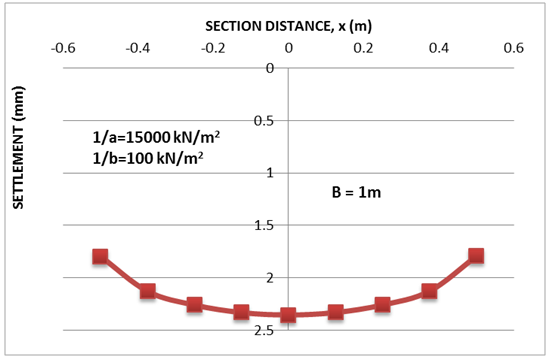 | Figure 2. Settlement pattern for q = 25 kN/m2 |
 | Figure 3. Settlement pattern for q = 50 kN/m2 |
Typical bearing pressure versus settlement curves for different combinations of 1/a and 1/b values are given in Figs 4, 5, 6, 7 and 8 considering B=1.0m. It is evident from these figures that pressure-settlement characteristics improves with the increase in 1/a and 1/b values. It is due to the fact that higher values of 1/a and 1/b indicate better soil.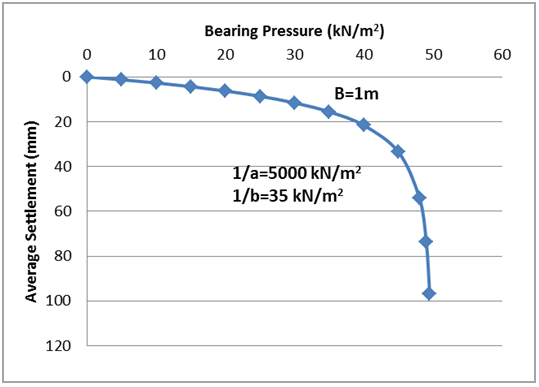 | Figure 4. Pressure-average settlement curve |
 | Figure 5. Pressure-average settlement curve |
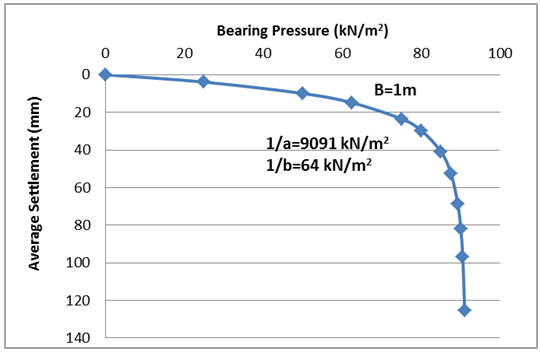 | Figure 6. Pressure-average settlement curve |
 | Figure 7. Pressure-average settlement curve |
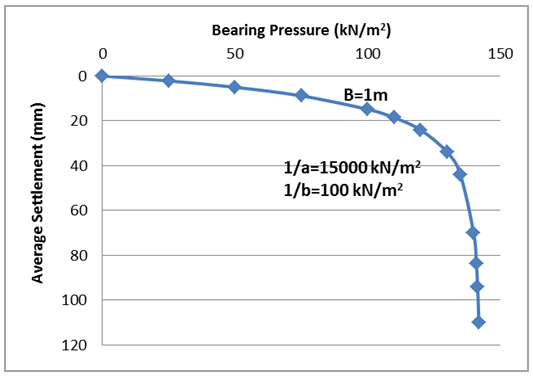 | Figure 8. Pressure-average settlement curve |
This point has been highlighted in Figs. 9 and 10, i.e. for a given value of 1/b, settlement of a footing same pressure intensity decreases with the increase in 1/a. Similar trend has been observed for a given value of 1/a, variation of settlement with respect to 1/b.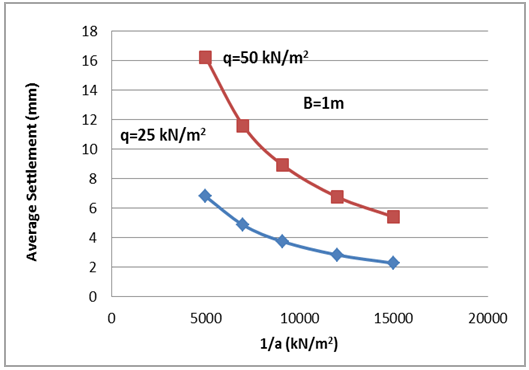 | Figure 9. Average settlement -1/a curve |
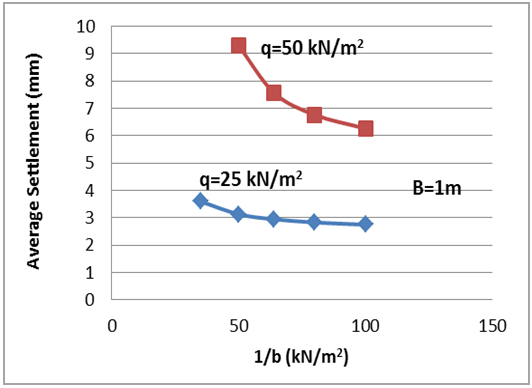 | Figure 10. Average settlement -1/b curve |
Settlement of a footing for given values of 1/a and 1/b and pressure intensity increases with the width of the footing linearly (Figs.11). These have been observed earlier also by many investigators including [15]. | Figure 11. Pressure-average settlement curve |
5. Conclusions
1) Evaluation of pressure-settlement characteristics of an actual footing using constitutive law of soil enable its complete proportioning. Bearing capacity can be obtained using intersection tangent method. Settlement of the footing for the design pressure can be read confidently from it. 2) Pressure-settlement characteristic of a footing improves with the increase in the values of Kondner’s hyperbola parameters.Further it may be noted from the pressure-settlement characteristics that the bearing capacity of the footing may conveniently obtained using intersection tangent method. Thus from Figs. 4 to 8, bearing capacities are obtained as below: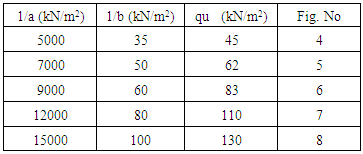
Illustrative Example
Design a wall footing which carries a load of 40 kN/m. The properties of underground soil which is saturated clay has been obtained by performing triaxial test. It gives 1/a=15000 kN/m2; 1/b=100 kN/m2;Assume permissible settlement as 20mm as Solution:a) Assume the width of the footing as 1.0 m. Obtain Pressure-settlement characteristics of the footing using the methodology described in the paper. It will work out as shown in Fig.8. This curve gives ultimate bearing capacity as 130 kN/m2. Therefore, the footing wall will be able to carry a load equal to (140/3) x1=43 kN/m, hence safer it is more than 12 kN/m.b) Pressure on the footing= (40/1) =40 kN/m2. For pressure intensity of 40 kN/m2, settlement of the footing works at to be about 5 mm which is much less than the permissible settlement 20mm.
ACKNOWLEDGEMENTS
This is a part of the thesis work. The first author (TB) is indebted to Head, Department of Earthquake Engineering, IIT Roorkee, Roorkee for excellent computational facilities to carry out the work.
References
| [1] | Agarwal, R.K. (1986), “Behaviour of Shallow Foundations Subjected To Eccentric-Inclined Loads” Ph.D Thesis, University of Roorkee, Roorkee. |
| [2] | Chakraborty, Debarghya. "Bearing capacity of strip footings by incorporating a non-associated flow rule in lower bound limit analysis." International Journal of Geotechnical Engineering 10, no. 3 (2016): 311-315. |
| [3] | Dai, Zi Hang, and Xiang Xu. "Comparison of analytical solutions with finite element solutions for ultimate bearing capacity of strip footings." In Applied Mechanics and Materials, vol. 353, pp. 3294-3303. Trans Tech Publications, 2013. |
| [4] | Dai, Zi Hang, and Xiang Xu. "Comparison of analytical solutions with finite element solutions for ultimate bearing capacity of strip footings." In Applied Mechanics and Materials, vol. 353, pp. 3294-3303. Trans Tech Publications, 2013. |
| [5] | Han, Dongdong, Xinyu Xie, Lingwei Zheng, and Li Huang. "The bearing capacity factor Nγ of strip footings on c–ϕ–γ soil using the method of characteristics." SpringerPlus 5, no. 1 (2016): 1482. |
| [6] | Kumar, Jyant. "N γ for rough strip footing using the method of characteristics." Canadian Geotechnical Journal 40, no. 3 (2003): 669-674. |
| [7] | Kumar, Jyant. "The variation of Nγ with footing roughness using the method of characteristics." International Journal for Numerical and Analytical Methods in Geomechanics 33, no. 2 (2009): 275-284. |
| [8] | Loukidis, D., and R. Salgado. "Bearing capacity of strip and circular footings in sand using finite elements." Computers and Geotechnics 36, no. 5 (2009): 871-879. |
| [9] | Meyerhof, G.G. (1951.), “Ultimate Bearing Capacity of Foundation”, Geotechnique, Vol.2, N0.4, pp.301-331. |
| [10] | Peck, R.B, Hanson, W.E and T.H. Thornburn (1974), “Foundation Engineering”, 2nd Edition, John Wily and sons, N.Y. |
| [11] | Saran, S., (2010), “Analysis and Design of Substructures”, Oxford and IBH Publishing Co. Pvt. Ltd., New Delhi. |
| [12] | Sharan, U.N. (1977), “Pressure Settlement Characteristics of Surface Footings Using Constitutive Laws”, Ph.D Thesis, University pf Roorkee, Roorkee |
| [13] | Sun, Jian-Ping, Zhi-Ye Zhao, and Yi-Pik Cheng. "Bearing capacity analysis using the method of characteristics." Acta Mechanica Sinica 29, no. 2 (2013): 179-188. |
| [14] | Terzaghi, K. (1943), “Theoretical Soil Mechanics, John Willey and Sons”, Inc. N.Y.1943. |
| [15] | Terzaghi, K. and Peck, R B. (1967), “Soil Mechanics in Engineeri.ng Practice”, John Wiley and Sons Inc. New York, 1967. |




 .Determine the stresses
.Determine the stresses  at this point due to applied stress using theory of elasticity. Using these values of stresses, obtain the values of principal stresses
at this point due to applied stress using theory of elasticity. Using these values of stresses, obtain the values of principal stresses 
 and their directions
and their directions  with vertical in usual way.iv) In case of clays value of principal strain
with vertical in usual way.iv) In case of clays value of principal strain  in the direction major principal stress may be obtained as per Eq.(1)
in the direction major principal stress may be obtained as per Eq.(1)




 is Poisson’s ratiov) Vertical strain at the selected point will then be:
is Poisson’s ratiov) Vertical strain at the selected point will then be:

 = total settlement along ith vertical section,
= total settlement along ith vertical section, = vertical strain at depth z below the base of footing.
= vertical strain at depth z below the base of footing. = thickness of strips at depth z, andn = number of strips in which the soil strata upto significant depth is divided. In this way values of total settlements along other vertical sections passing through the base of footing are obtained.
= thickness of strips at depth z, andn = number of strips in which the soil strata upto significant depth is divided. In this way values of total settlements along other vertical sections passing through the base of footing are obtained.  Pressure Intensity, q (kN/m2): 5 to 120 (Depending on the values of 1/a and 1/b).For illustration, for 1/a =15000; 1/b =100 and B=1.0m, settlements of equally spaced nine points of the base were obtained for different pressure intensities. Typical plots showing the settlement patterns for pressure intensities 25 and 50 are shown in Figs 2 and 3 respectively. It is evident that these settlement patterns are parabolic in nature having maximum settlement at the centre of the footing. It was concluded by earlier investigations [12]; [1] that the settlement of the equivalent rigid footing i.e. of the same width is almost equal to the average settlement of a flexible footing. It is obtained by dividing the area of the settlement diagram (i.e. as shown in Figs 2 and 3) by the width of footing. Plots of pressure versus settlement curves have been prepared using the average settlement i.e. considering the footing base as rigid.
Pressure Intensity, q (kN/m2): 5 to 120 (Depending on the values of 1/a and 1/b).For illustration, for 1/a =15000; 1/b =100 and B=1.0m, settlements of equally spaced nine points of the base were obtained for different pressure intensities. Typical plots showing the settlement patterns for pressure intensities 25 and 50 are shown in Figs 2 and 3 respectively. It is evident that these settlement patterns are parabolic in nature having maximum settlement at the centre of the footing. It was concluded by earlier investigations [12]; [1] that the settlement of the equivalent rigid footing i.e. of the same width is almost equal to the average settlement of a flexible footing. It is obtained by dividing the area of the settlement diagram (i.e. as shown in Figs 2 and 3) by the width of footing. Plots of pressure versus settlement curves have been prepared using the average settlement i.e. considering the footing base as rigid.










 Abstract
Abstract Reference
Reference Full-Text PDF
Full-Text PDF Full-text HTML
Full-text HTML